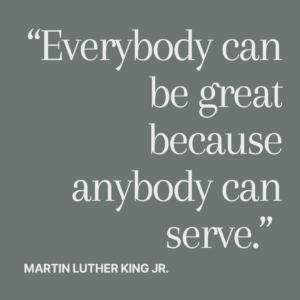 We believe fighting anti-blackness and speaking out against oppression of all forms deeply matters to the health of our communities and classrooms. As educators, we can create opportunities for young people to reflect on injustices, advocate for themselves, and contribute to their community for a more just world.
We believe fighting anti-blackness and speaking out against oppression of all forms deeply matters to the health of our communities and classrooms. As educators, we can create opportunities for young people to reflect on injustices, advocate for themselves, and contribute to their community for a more just world.
Meaningful contributions not only help our community, but they also cultivate a sense of belonging and significance for young people. Get started or add to your current practices with a few of these suggestions:
Incorporate Community Care & Advocacy into Your Classroom
Build your students advocacy skills and encourage community by practicing community care and providing advocacy opportunities in your classroom. This resource from The Practice Space is full of ideas for incorporating advocacy skills into your daily classroom routine, such as students asking their peers for help brainstorming solutions to a social problem.
Study Social Change Makers
Glean inspiration by studying the life work of social change makers. This could include Dr. Martin Luther King Jr., as well as lesser known activists such as Ella Baker and Claudette Colvin. Shifting our perspective about who can be activists is also helpful – take a look at this resource for why students make excellent change makers, and this inspiring example of student activists.
Utilize Learning Interest Inventories
According to Edutopia, learning interest inventories “allow you and your students to identify areas of interest and ways of finding joy in learning and demonstrating that learning.” They also provide opportunities for students to reflect and self-advocate for their areas of interest, and to share power in the classroom. Dynamic, engaged learning occurs when students have a say in their curriculum, and provides an opportunity to practice self-advocacy skills.
Provide Tools for Student Voice
Skills such as self-advocacy need to be practiced over and over to sink in. Provide tools such as graphic organizers, sentence stems, and word banks – they are a great way to provide some structure for student self-reflection and self-advocacy. Give students language for how they are potentially feeling or how they’d like to contribute to their community.
Cultivate Classroom-Wide Connection
Co-create a classroom environment of openness, trust, and belonging, which sets the scene for students to feel comfortable advocating for their needs and the needs of their community.
Speaking up can be difficult, especially for students with marginalized identities who may not feel like their voice will be heard nor valued. Creating daily practices of connection with your students helps build a classroom community of curiosity and risk-taking. This can include social/emotional learning games and small group conversations for students who don’t feel comfortable speaking up in front of a large group.
Provide ample and varied opportunities for connection and self-reflection. This is the key to allowing students to practice getting to know themselves and their community.
Kayla Blau is a Sound Discipline Facilitator
